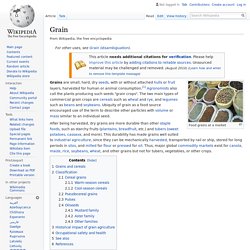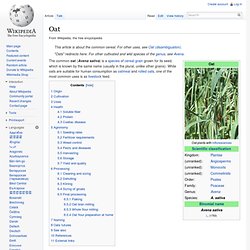

Food grain. Grains and cereals[edit] In botany, grains and cereals are synonymous with caryopses, the fruits of the grass family.

In agronomy and commerce, seeds or fruits from other plant families are called grains if they resemble caryopses. For example, amaranth is sold as "grain amaranth", and amaranth products may be described as "whole grains". The pre-Hispanic civilizations of the Andes had grain-based food systems but, at the higher elevations, none of the grains was a cereal. All three grains native to the Andes (kaniwa, kiwicha, and quinoa) are broad-leafed plants rather than grasses such as corn, rice, and wheat.[2] Classification[edit] Cereal grains[edit] All cereal crops are members of the grass family (Poaceae).[3] Cereal grains contain a substantial amount of starch,[4] a carbohydrate that provides dietary energy. Warm-season cereals[edit] Cool-season cereals[edit] Pseudocereal grains[edit] Starchy grains from broadleaf (dicot) plant families:
Buckwheat. Field of buckwheat in Bumthang (Bhutan) Buckwheat (Fagopyrum esculentum), also known as common buckwheat, Japanese buckwheat and silverhull buckwheat,[2] is a plant cultivated for its grain-like seeds and as a cover crop.

A related and more bitter species, Fagopyrum tataricum, a domesticated food plant common in Asia, but not as common in Europe or North America, is also referred to as buckwheat. Despite the name, buckwheat is not related to wheat, as it is not a grass. Instead, buckwheat is related to sorrel, knotweed, and rhubarb. Because its seeds are rich in complex carbohydrates, it is referred to as a pseudocereal. The cultivation of buckwheat grain declined sharply in the 20th century with the adoption of nitrogen fertilizer that increased the productivity of other staples. Etymology[edit] The name "buckwheat" or "beech wheat" comes from its triangular seeds, which resemble the much larger seeds of the beech nut from the beech tree, and the fact that it is used like wheat.
Oat. The common oat (Avena sativa) is a species of cereal grain grown for its seed, which is known by the same name (usually in the plural, unlike other grains).

While oats are suitable for human consumption as oatmeal and rolled oats, one of the most common uses is as livestock feed. Origin[edit] The wild ancestor of Avena sativa and the closely related minor crop, A. byzantina, is the hexaploid wild oat A. sterilis. Genetic evidence shows the ancestral forms of A. sterilis grew in the Fertile Crescent of the Near East. Domesticated oats appear relatively late, and far from the Near East, in Bronze Age Europe. Cultivation[edit] Oats are grown in temperate regions. On the Indian subcontinent, oats (known locally in Hindi, Punjabi, Awadhi, Bhojpuri, and Nepali languages as "jaei" (जौ)) are grown on the foothills of Himalayas, such as in the Indian state of Punjab, Uttar Pradesh and Bihar.
Worldwide oat production Uses[edit] Closeup of oat florets (small flowers) Barley. Barley (Hordeum vulgare L.), a member of the grass family, is a major cereal grain.

It was one of the first cultivated grains and is now grown widely. Barley grain is a staple in Tibetan cuisine and was eaten widely by peasants in Medieval Europe. Barley has also been used as animal fodder, as a source of fermentable material for beer and certain distilled beverages, and as a component of various health foods. It is used in soups and stews, and in barley bread of various cultures. Barley grains are commonly made into malt in a traditional and ancient method of preparation. In a 2007 ranking of cereal crops in the world, barley was fourth both in terms of quantity produced (136 million tons) and in area of cultivation (566,000 square kilometres or 219,000 square miles).[2] Etymology[edit] Biology[edit] Barley Barley is a member of the grass family. Domestication[edit] Two-row and six-row barley[edit] Two-row and six-row barley.